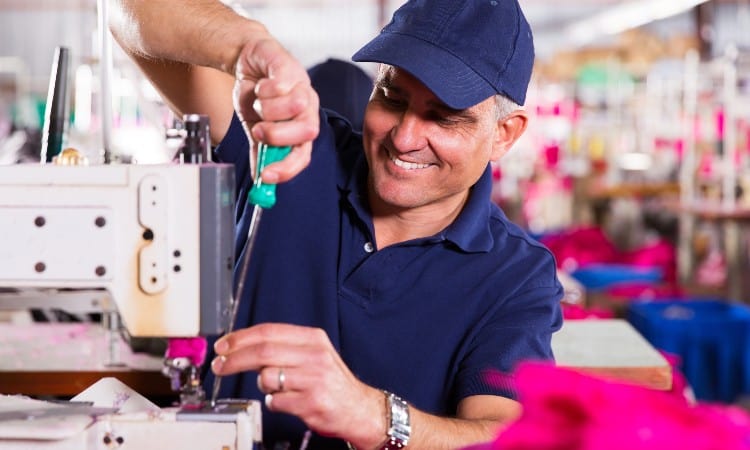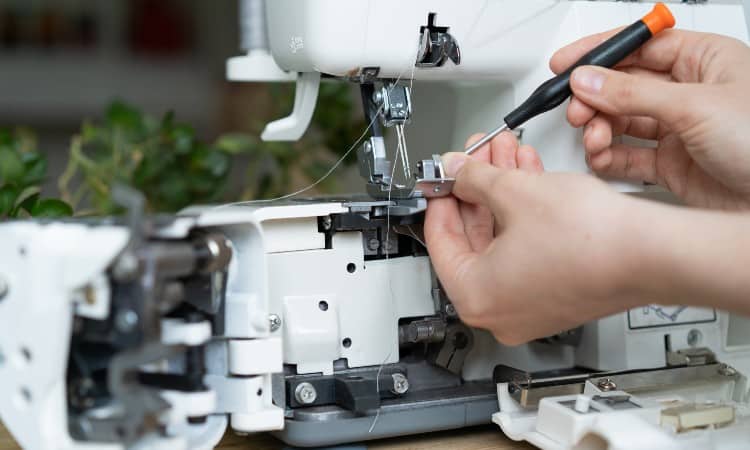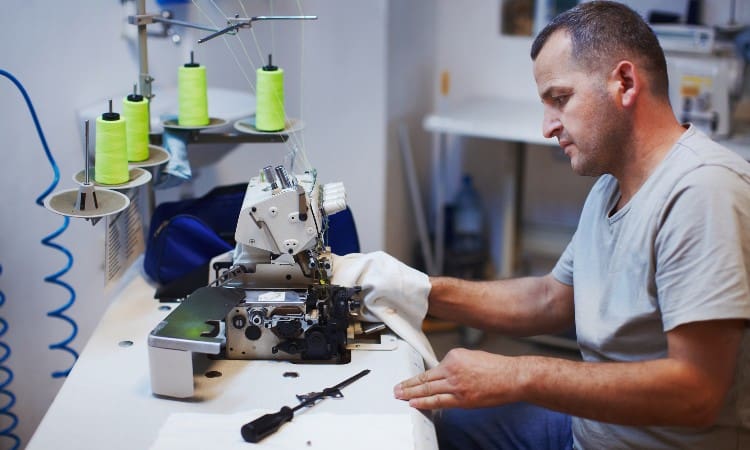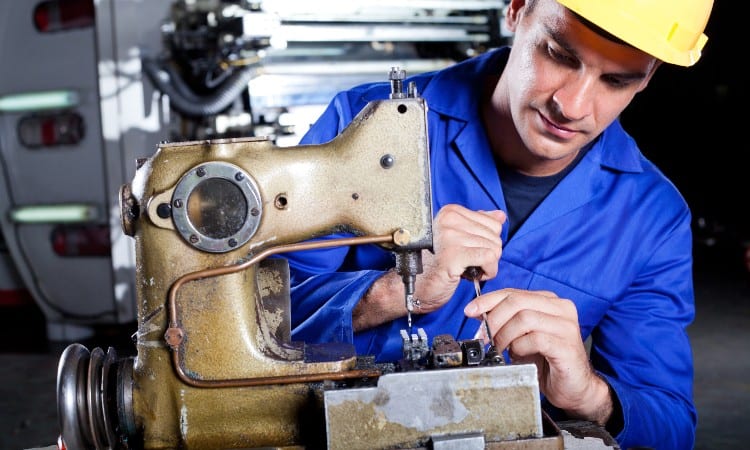Whether you have a brand-new computerized sewing machine or a cast-iron vintage model, it will eventually break down and need repairs. When this happens, you can put on your DIY hat, watch some Youtube videos, and hope for the best. If that fails, you will find yourself wondering, how do I find a sewing machine repair shop near me?
You can find a nearby sewing machine repair shop through Google, Yellowpages, the local classifieds, or online sewing forums. Most basic sewing machine repairs cost around $75-$100. When you find a nearby repair shop, you should make sure the technicians can repair your make and model of machine.
In this article, you will learn all about what sewing machine repair shops do. You will also find information on getting the best help for your particular make and model of machine. Finally, you will get tips for how to try a few simple, quick fixes on your own!

Sewing Machine Repair Shops
Sewing machine repair shops offer professional technicians who know how to repair the ins and outs of sewing machine parts and motors. These shops range in size from large dealerships that offer repair services to tiny mom-and-pop joints in small towns.
If you bought a brand-new machine from a dealership, such as an official Bernina dealer, you should check with them first. New machines have a special warranty that gives you the right to free or low-cost servicing at the dealership. Plus, if you go elsewhere, you may void that warranty!
If you have an older machine or bought your new machine off Amazon or at Hobby Lobby, chances are you don’t have that special warranty and will need to track down a nearby shop for help and repairs.
Most sewing machine repair shops can fix basic issues such as a needle that won’t move up and down or belts that need replacing. Some shops specialize in certain brands of sewing machines, such as Bernina or Singer.
All good sewing machine repair shops have certified technicians, though not every technician will have certification to repair every kind of sewing machine.
These days, pretty much every shop will have a website. You need to check this out before calling to make an appointment! The website should tell you what kinds of sewing machines the shop can handle. It will also provide key info, such as whether the shop offers a 30-day or even 90-day warranty on the repairs.
The repair warranty lets you know that the shop will stand behind its repairs and look at the machine again for free if necessary to fix the issue!
The age of your machine can also make a difference. Many repair technicians, especially in small local shops, will probably take a look at a vintage machine. That said, many certified technicians for dealerships–or technicians who specialize in just one or two brands–may not have the training to look at an old machine.
Does the brand matter? Like any appliance, different manufacturers use different designs, parts, and materials to make their sewing machines. This is why you need to make sure your local shop can work on your brand of machine.
Plus, lots of older sewing machine brands, like Kenmore and White, no longer exist. This means that finding replacement parts can get tricky!
Sewing Machine Repair Shop Near Me

In today’s digital world, the easiest way to find a nearby sewing machine repair shop is to use Google! Just plugging in “sewing machine shop near me” will give you lots of websites to look at. You will still need to do a bit of leg work to narrow down which shops meet your needs, though!
First, the website should list what kinds of sewing machines the shop can handle. Make sure your machine falls into one of those categories!
Second, scroll through quickly to see if the website mentions technician certifications. Most technicians have certifications to prove that they know how to repair a range of sewing machines.
Finally, look for an indication that the shop offers a repair warranty. This means that if they didn’t succeed in fixing the issue the first time, they will look at your machine again for free! In general, reputable shops should always offer this courtesy.
You can also check out the Yellow Pages or the classifieds in your local paper to find relevant ads about local shops. While it sounds old-school, this lets you find those tiny, old-fashioned mom-and-pop shops that may not have employees who feel comfortable making a website.
If you want to get the down-low on your local sewing community, try joining a quilting or sewing group at a church, community organization, or fabric store. These oldtimers will know all there is to know about the nearby repair shops!
If you feel comfortable joining an online forum, you can find many sewing discussion groups full of people who love sewing and are always willing to share tips about the best repair shops they have used.
Once you find a shop that looks good, give them a call to find out if they are a good fit. Before making the call, jot down the make, model, and serial number of your machine, as well as a concise explanation of what’s wrong with your machine. You will want this at hand to quickly explain the situation to the technician during your call.
You should also have a list of questions you want to ask ready to go. These might include:
- What kind of certification do you have for my brand of sewing machine?
- How much does a basic repair cost at your shop?
- Do you offer a repair warranty?
- Does this sound like a fixable issue?
- WIll I need replacement parts?
Finally, make sure you bring all the necessary components of your machine with you when you head in for your appointment! This includes your machine (obviously!), the power cord, the presser foot, and any necessary accessories such as zigzag cams for older machines or the embroidery hoop for an embroidery machine.
How Much Does a Sewing Machine Repair Cost?
A regular tune-up or simple repair typically costs around $75-$100, though more complex repairs involving replacement parts may cost a lot more. Most technicians charge for their time, though some shops may charge by the kind of repair instead. For example, they may have a flat fee for a basic tune-up.
Usually, the repair fee comes down to how long it takes the technician to fix the problem. Like car mechanics, these professionals have extensive training and knowledge to perform the complicated mechanical and computerized repairs your machine may require.
Most repair technicians don’t charge as much for their time as the average lawyer, but they have specialized knowledge you can’t find anywhere else! This allows them to set a pretty high price on their work.
Sewing machine repair does cost a lot, especially when you consider that many beginner or vintage machines only cost around $100, to begin with! Because of this, you should honestly evaluate if you will save more money by replacing your machine.
If your machine has sentimental value, is a stellar brand, or is fairly new, you probably want to get it repaired. If it’s an old hand-me-down or you found it at a yard sale for cheap, you may want to start looking for a new machine instead of paying a lot of money to get an old clunker up and running again.
And, of course, you can teach yourself some basic cleaning and repair methods as well, if you want to save money!
Singer Sewing Machine Repair Near My Location

Finding a nearby Singer sewing machine repair should be easy because Singer remains one of the most successful, most popular sewing machine brands in the world, an honor it has held onto for more than a century!
This venerable company offers excellent customer support through its website. You can find technical support for lots of common issues, as well as an easily searchable shop for accessories and parts.
On top of this, Singer sells so many hundreds of thousands of machines every year that most (if not all) technicians get certified to repair Singer models!
The bottom line is that you should have an easy time finding a certified, reputable Singer sewing machine repair technician.
Now, while Singer has a great reputation, they don’t necessarily make the absolute best high-end machines, either. They tend to focus on beginner or dedicated home sewer-level machines.
You will see several common issues while using the average Singer model. These may include:
- Jerky fabric feed
- Repeated broken needles
- Fabric jammed up/needle not going up and down
- Grinding noises coming out of the motor
- Puckered seams, skipped stitches, or “bird’s nesting” thread
Kenmore Sewing Machine Repair Near Me
You may struggle to find a store dedicated just to Kenmore sewing machine repairs. That said, many older technicians still have the skills necessary to fix these machines. You will just have to look a bit harder to find them!
What makes Kenmore machines different? Well, Sears Roebuck used this brand name on many of its appliances. However, they stopped making sewing machines back in the early 2000s, after a bankruptcy and a buyout shook up the whole company.
For this reason, it gets harder and harder to find parts, support, or repair technicians for Kenmore models as time goes by.
On top of this, all Kenmore machines, by definition, will be vintage models by today’s standards. Lots of sewing machine repair technicians feel comfortable working on old machines, but not all of them.
You may run into a variety of issues with these older machines, but some common errors include:
- The bobbin won’t spin, or the bobbin thread won’t catch.
- The machine won’t turn on at all.
- Zig-zag stitching won’t work. (This is an especially common problem because the cams used to create this stitch are often made of plastic that wears out over time).
- The handwheel won’t turn.
Authorized Brother Sewing Machine Repair Near Me
You should find it quite easy to track down an authorized Brother sewing machine repair technician. Like Singer, Brother has a long history as a reputable sewing machine manufacturer. The companies got their start around the same time, in the late 1800s, though Brother is a Japanese company, and Singer is American.
Brother stands the test of time as a respected, innovative, and competitive sewing machine company today. The company provides some practical support through its website, including a searchable browser to locate Brother dealers.
As you probably remember, many dealers provide repair and maintenance services, as well as new machines. You can usually find Brother-certified repair technicians in generic sewing machine repair shops, too!
The only thing you won’t find easily is help for vintage Brother machines. For a while, Brother made “badged” machines sold under many different American brand names. It’s quite tricky to find any information or help for these older models.
Like all sewing machines, Brother models can run into some common issues.
- The machine won’t stay threaded.
- The thread repeatedly breaks while sewing.
- Fabric or thread jams up beneath the presser foot.
- A hook timing error causes the bobbin thread to slip free.
- The machine won’t sew in reverse. Newer Brother machines will often indicate an error code on the LCD or touchscreen. You can look in the manual to find out what this error means.
Mini Sewing Machine Repair Shop Near Me
Mini sewing machine repair shops are few and far between, though regular sewing machine technicians will often offer to take a look at your mini model.
Here’s the deal: mini machines, often bought as toys for children or “quick fix” solutions like replacing a ripped hem, don’t have much functionality, and they aren’t built to last.
These miniature sewing machines have even smaller parts than regular sewing machines. Usually, the parts are made of cheap plastic.
On top of this, mini sewing machines typically cost less than $50 (though this does depend on the brand name). If you only paid $50 for the machine, you would feel silly paying $100 to get it looked at!
The good news is that you can often make basic adjustments yourself that will keep the mini machine running cost-effectively!
The biggest frustration of a mini sewing machine users face is that the little guys just won’t stitch. Of course, this can have several different causes, but it’s annoying when it happens, no matter what the cause!
Other common ailments include:
- Broken needles or a bent needle that keeps jamming.
- The wrong needle (possibly too long), causing the machine to refuse to stitch.
- Bird’s-nesting thread beneath the fabric as you try to sew.
- Bobbin tension issues resulting in breaking bobbin thread.
Can I Fix My Own Sewing Machine?

If you like fixing things and you have a bit of time to put into learning how sewing machines work, you can typically repair all but the most serious issues yourself. Much of the time, all you have to do is replace a simple part like a needle or give the machine a good cleaning to get it up and running again!
Even if you don’t want to spend a lot of time repairing your machine, you should know the basics of how it works, what all the parts do, and how to take them in and out just to make you a better sewer.
For example, knowing how to adjust tension will allow you to sew effectively on many different fabric types. Knowing how to replace the needle will prevent puckers and pulled threads as you sew.
Plus, if you know all the parts in your machine by name, you will understand what the technician is talking about if you have to take your machine into the shop! (If you have ever had a embarrassing interaction with a car mechanic, in which he or she had to explain how a basic part of your car functions as if you were a kindergartner, you know exactly why this matters!).
How do you learn this important knowledge? Read your sewing machine manual, watch Youtube videos, or visit the manufacturer’s website. You’ll find a wealth of knowledge at your fingertips!
The next step is learning how to clean your machine. You don’t have to commit to full-scale repairs to make a difference in your machine! Try these simple steps to keep your machine purring along like a happy kitten.
- First, unplug your sewing machine. This step will prevent all manner of accidents down the road!
- Next, give the body of the machine a quick dusting. You should probably do this every time you sit down to sew!
- Take out the bobbin. Take a quick picture of the bobbin casing and then remove it. Use a small brush to clear away any accumulated lint from this area.
- Do the same thing with the throat plate. Remove it (this may require a small screwdriver), and then get rid of built-up lint.
- You may feel like you would save time by using a small vacuum or one of those keyboard pressurized air cans, but this is a bad idea! Stick with a gentle hand and a small brush that will not wedge lint into a bad place or suck up a key part of your sewing machine!
- Finally, some machines require careful application of sewing machine oil, usually on any part that moves as you sew. Read your manual to find out if you should apply oil. If you do need oil, make sure you only use appropriate sewing machine oil!
If you mastered the knowledge and the cleaning, you may feel ready to embrace the idea of simple repairs! Not every sewing machine issue has an easy fix, but this brief list offers several common problems you can quickly correct yourself.
- If everything jams up: cut away the tangled thread and fabric from beneath the presser foot. Rethread the thread path (the thread that goes from the spool to the needle) and the bobbin. At least 75% of the time, rethreading the machine will fix your sewing machine issue!
- If you have a broken needle, puckered fabric, or repeatedly breaking thread: try replacing the needle. Honestly, you should slot in a new needle every time you begin a new project! Dull needles cause all kinds of problems as you sew.
- If you get skipped stitches or bunching stitches: adjust the tension mechanism. This determines how much “push” the feed dogs give the fabric as they slide it beneath the presser foot. Every fabric has a unique texture that requires more or less tension as you sew.
- If you keep hearing a weird sound: stop sewing and unplug everything! Then check the bobbin area and also check to see if the needle has bent. A bent needle or misaligned bobbin could catch on other moving parts and make strange sounds.
So, when do you need to take the machine to the shop? Well, if you can’t find a replacement part easily, you might need to reach out to a professional for help.
Also, if you run into a computer programming issue, you will likely need a technician to reset a code in the sewing machine. Finally, unless you know a great deal about small engine repair, you probably want to leave wiring or anything electrical to the experts, too!
Conclusion
The easiest way to find a nearby sewing machine repair shop is to Google it, check the Yellowpages, or join an in-person or online sewing group. If you use the internet, make sure you look for a repair warranty to know you have found a reputable shop!
Finding a sewing machine repair shop near you is easy, but you still need to verify that the shop has the appropriate certifications before making an appointment. You also want to make sure that the technicians know how to repair your particular make and model of machine because some repair technicians specialize in certain brands.
Have you ever had your sewing machine repaired? Where did you take it? Leave a comment below to let us know!